Detailed analysis of Python keywords
This article brings you relevant knowledge about python, which mainly introduces related issues about keywords. It analyzes Python’s keyword knowledge points in detail based on examples. I hope it will be useful to everyone. help.

Recommended learning: python detailed tutorial
1 and, or, not
and, or, not The keywords are all logical operators and are used as follows:
- and: If both statements return True, the return value will be True only, otherwise it will return False.
- or: If one of the statements returns True, the return value is True, otherwise it returns False.
- not: If the statement is not True, the return value is True, otherwise it returns False.
x1 = (5 > 3 and 5 3 or 5 > 10)x2 x3 = Falsenot x3
The results are as follows: 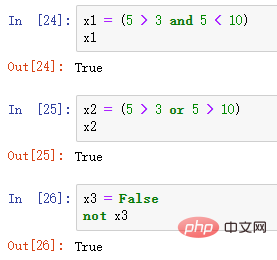
2 if, elif, else
if, elif, else are mainly used for conditional statements. The usage is as follows :
- if: Used to create conditional statements (if statements), and allows the if code block to be executed only when the condition is True.
- elif: Used in conditional statements (if statements), it is the abbreviation of else if.
- else: Used in conditional statements (if statements) and determines the code to be executed when the if condition is False.
def func(x):
if x <p>The result is as follows: <br><img src="/static/imghw/default1.png" data-src="https://img.php.cn/upload/article/000/000/067/fe1421fd000ace756583a0e389d5c9c7-2.png" class="lazy" alt="Detailed analysis of Python keywords"><br> Among them, the else keyword is also used in the try...except block, please see the example below. </p><pre class="brush:php;toolbar:false">def func1(x):
try:
100//x except:
print("ZeropisionError: pision by zero(除数不能是0)")
else:
print(f"程序计算结果是{str(100//x)}")func1(10)func1(0)The results are as follows: 
3 for, while
for, while are mainly used to define a loop, the usage is as follows:
- for: Used to create a for loop, which can be used to traverse sequences, such as lists, tuples, etc.
- while: used to define a while loop, the while loop will continue until the condition of while is False.
name_list = ["张三","李四","王五"]for name in name_list: print(name)
The results are as follows: 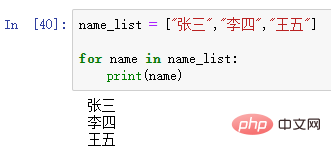
x = 0while x<p>The results are as follows: <br><img src="/static/imghw/default1.png" data-src="https://img.php.cn/upload/article/000/000/067/fe1421fd000ace756583a0e389d5c9c7-5.png" class="lazy" alt="Detailed analysis of Python keywords"></p><h2 id="True-False">4 True, False</h2><p>True and False are the results returned by the comparison operation. The usage is as follows: </p>
- True: The keyword True is the same as 1.
- False: The keyword False is the same as 0.
print(9 > 6)print(6 in [11,6,33])print(5 is 5)print(5 == 5)print(5 == 5 and 7 == 7)print(5 == 5 or 6 == 7)print(not(5 == 7))
The results are as follows: 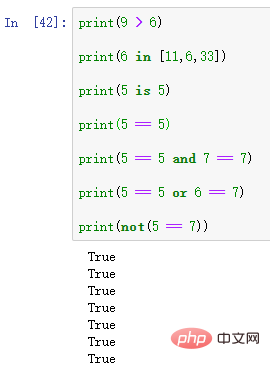
print(9 = 7)print(not(5 == 5))
The results are as follows: 
5 continue、break
continue and break are mainly used in for loops and while loops. The usage is as follows:
- continue: The continue keyword is used to end the current iteration in the for loop (or while loop) and continue to the next an iteration.
- break: The break keyword is used to interrupt a for loop or while loop.
for i in range(10): if i <p>The results are as follows: <br><img src="/static/imghw/default1.png" data-src="https://img.php.cn/upload/article/000/000/067/33a9dc96ec9650f787ea254e66c73254-8.png" class="lazy" alt="Detailed analysis of Python keywords"></p><pre class="brush:php;toolbar:false">x = 0while x <p>The results are as follows: <br><img src="/static/imghw/default1.png" data-src="https://img.php.cn/upload/article/000/000/067/33a9dc96ec9650f787ea254e66c73254-9.png" class="lazy" alt="Detailed analysis of Python keywords"></p><h2 id="pass">6 pass</h2><p>pass Statements serve as placeholders for future code. When the pass statement is executed, it will not have any effect. It is just a placeholder that represents blank code. However, if you do not write anything, an error will be reported. If empty code is not allowed in loops, function definitions, class definitions or if statements, pass can be used. <br><img src="/static/imghw/default1.png" data-src="https://img.php.cn/upload/article/000/000/067/33a9dc96ec9650f787ea254e66c73254-10.png" class="lazy" alt="Detailed analysis of Python keywords"></p><h2 id="try-except-finally-raise">7 try, except, finally, raise</h2><p>try, except, finally, and raise are all keywords related to exceptions. The usage is as follows: </p>
- try:在try…except块中使用,它定义了一个代码块,并在没有问题的情况下执行块。如果包含任何错误,可以为不同的错误类型定义不同的块。
- except:在try… except块中使用。 如果try块引发错误,并在有问题的情况下执行对应的代码块。
- finally:在try…except块中使用。它定义了一个代码块,当try…except…else块结束时,该代码块将运行。无论try块是否引发错误,都将执行finally代码块。
- raise:raise关键字用于引发异常,可以定义引发哪种错误,以及向用户显示错误信息。
def func(x):
try:
100 // x except:
print("ZeropisionError: pision by zero(除数不能是0)")
else:
print(f"结果是:{str(100 // x)}")
finally:
print("无论如何,都会执行!")
func(10)func(0)结果如下: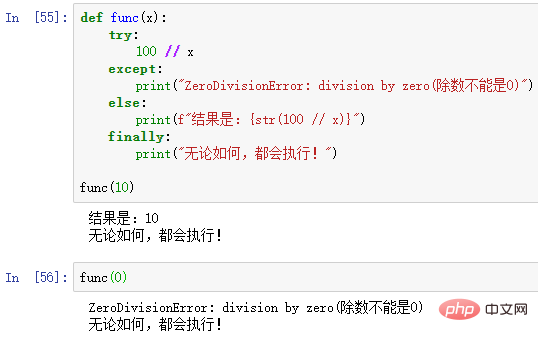
x = 15if x <p>结果如下:<br><img src="/static/imghw/default1.png" data-src="https://img.php.cn/upload/article/000/000/067/dcff06d9f769f18601bb11c4301d30c1-12.png" class="lazy" alt="Detailed analysis of Python keywords"></p><h2 id="import-from-as">8 import、from、as</h2><p>import、from、as均与模块的导入有关,用法如下:</p>
- import:用于导入模块。
- from:用于从模块中导入指定的部分,按需要导入指定子类或函数,减少不必要的资源浪费。
- as:用于创建别名。
import openpyxlimport pandas as pdfrom openpyxl import load_workbook()
9 def、return
def、return均与函数有关的关键字,用法如下:
- def:用于创建(或定义)一个函数。
- return:用于结束所定义的函数,并返回值。
def func1():
print("关注公众号:数据分析与统计学之美")
func1()结果如下:
def func2(x,y): return x + y func2(x=2,y=8)
结果如下: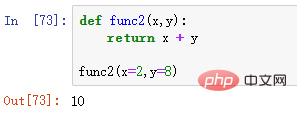
10 class
class关键字用于创建(或定义)一个类。
class Person: name = "张三" age = 18 p = Person()p.name,p.age
结果如下: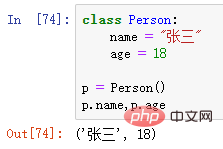
11 lambda
lambda关键字用于创建一个 “匿名函数”。
x = lambda a: a + 8x(2)y = lambda a,b: a + b y(1,1)z = lambda a,b,c: a * c + b z(2,5,5)
结果如下: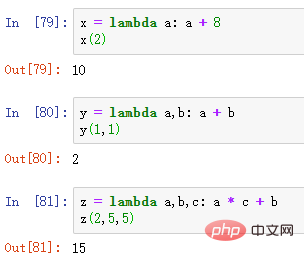
12 del
在Python中,一切皆对象。del关键字主要用于删除对象,还可以用于删除变量,列表或列表的一部分等。
x = 1del xprint(x)
结果如下: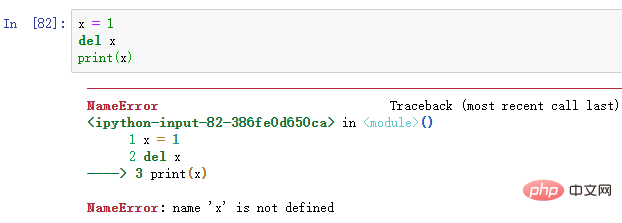
x = ["张三","李四","王五"]del x[0]print(x)
结果如下: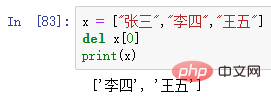
13 global、nonlocal
global关键字用于创建一个全局变量。nonlocal关键字用于声明一个非局部变量,用于标识外部作用域的变量。
# 定义一个函数:def func(): global x x = "函数中的变量"# 执行函数:func()# x定义在函数中,按说这里打印x会报错,我们看看print(x)
结果如下: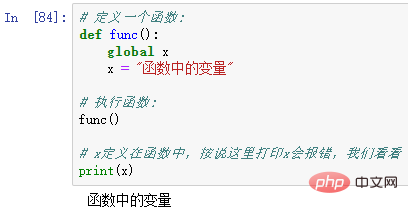
14 in、is
in、is这两个关键字大家一定要区别开来,用法如下:
- in:一方面可以用于检查序列(list,range,字符串等)中是否存在某个值。也可以用于遍历for循环中的序列。
- is:用于判断两个变量是否是同一个对象,如果两个对象是同一对象,则返回True,否则返回False。要与== 区别开来,使用==运算符判断两个变量是否相等。
x = ["张三","李四","王五"]"张三" in x# -------------------------for i in range(3): print(i)
结果如下: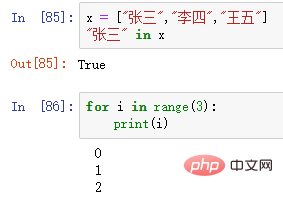
x = 2.0y = 2.0x is y x == y
结果如下: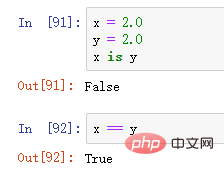
15 None
None关键字用于定义一个空值(根本没有值),与0,False或空字符串不同。 None是其自身的数据类型(NoneType),只能为None。
x = Noneprint(x)if x:
print("嘻嘻")else:
print("哈哈")结果如下: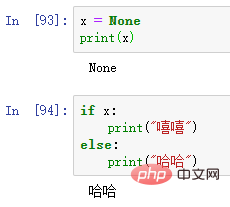
16 assert
调试代码时,使用assert关键字。主要用于测试代码中的条件是否为True,如果为False,将引发AssertionError。
x = 666assert x == 666assert x == 888,"x应该等于666,你的输入有误!"
结果如下: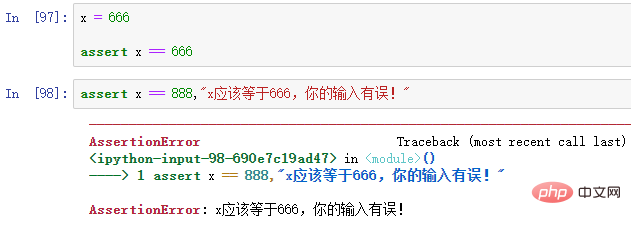
17 with
with常和open使用,用于读取或写入文件。
with open("哈哈.txt","r") as f:
print(f.read())结果如下: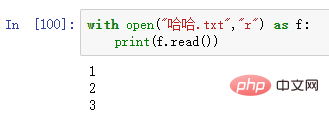
18 yield
yield关键字结束一个函数,返回一个生成器,用于从函数依次返回值。
def f(): yield 5f()next(f())
结果如下:
推荐学习:python教程
The above is the detailed content of Detailed analysis of Python keywords. For more information, please follow other related articles on the PHP Chinese website!

Hot AI Tools

Undresser.AI Undress
AI-powered app for creating realistic nude photos

AI Clothes Remover
Online AI tool for removing clothes from photos.

Undress AI Tool
Undress images for free

Clothoff.io
AI clothes remover

AI Hentai Generator
Generate AI Hentai for free.

Hot Article

Hot Tools

Notepad++7.3.1
Easy-to-use and free code editor

SublimeText3 Chinese version
Chinese version, very easy to use

Zend Studio 13.0.1
Powerful PHP integrated development environment

Dreamweaver CS6
Visual web development tools

SublimeText3 Mac version
God-level code editing software (SublimeText3)

Hot Topics
 Is the conversion speed fast when converting XML to PDF on mobile phone?
Apr 02, 2025 pm 10:09 PM
Is the conversion speed fast when converting XML to PDF on mobile phone?
Apr 02, 2025 pm 10:09 PM
The speed of mobile XML to PDF depends on the following factors: the complexity of XML structure. Mobile hardware configuration conversion method (library, algorithm) code quality optimization methods (select efficient libraries, optimize algorithms, cache data, and utilize multi-threading). Overall, there is no absolute answer and it needs to be optimized according to the specific situation.
 How to convert XML files to PDF on your phone?
Apr 02, 2025 pm 10:12 PM
How to convert XML files to PDF on your phone?
Apr 02, 2025 pm 10:12 PM
It is impossible to complete XML to PDF conversion directly on your phone with a single application. It is necessary to use cloud services, which can be achieved through two steps: 1. Convert XML to PDF in the cloud, 2. Access or download the converted PDF file on the mobile phone.
 What is the function of C language sum?
Apr 03, 2025 pm 02:21 PM
What is the function of C language sum?
Apr 03, 2025 pm 02:21 PM
There is no built-in sum function in C language, so it needs to be written by yourself. Sum can be achieved by traversing the array and accumulating elements: Loop version: Sum is calculated using for loop and array length. Pointer version: Use pointers to point to array elements, and efficient summing is achieved through self-increment pointers. Dynamically allocate array version: Dynamically allocate arrays and manage memory yourself, ensuring that allocated memory is freed to prevent memory leaks.
 Is there any mobile app that can convert XML into PDF?
Apr 02, 2025 pm 08:54 PM
Is there any mobile app that can convert XML into PDF?
Apr 02, 2025 pm 08:54 PM
An application that converts XML directly to PDF cannot be found because they are two fundamentally different formats. XML is used to store data, while PDF is used to display documents. To complete the transformation, you can use programming languages and libraries such as Python and ReportLab to parse XML data and generate PDF documents.
 How to convert xml into pictures
Apr 03, 2025 am 07:39 AM
How to convert xml into pictures
Apr 03, 2025 am 07:39 AM
XML can be converted to images by using an XSLT converter or image library. XSLT Converter: Use an XSLT processor and stylesheet to convert XML to images. Image Library: Use libraries such as PIL or ImageMagick to create images from XML data, such as drawing shapes and text.
 Recommended XML formatting tool
Apr 02, 2025 pm 09:03 PM
Recommended XML formatting tool
Apr 02, 2025 pm 09:03 PM
XML formatting tools can type code according to rules to improve readability and understanding. When selecting a tool, pay attention to customization capabilities, handling of special circumstances, performance and ease of use. Commonly used tool types include online tools, IDE plug-ins, and command-line tools.
 Is there a mobile app that can convert XML into PDF?
Apr 02, 2025 pm 09:45 PM
Is there a mobile app that can convert XML into PDF?
Apr 02, 2025 pm 09:45 PM
There is no APP that can convert all XML files into PDFs because the XML structure is flexible and diverse. The core of XML to PDF is to convert the data structure into a page layout, which requires parsing XML and generating PDF. Common methods include parsing XML using Python libraries such as ElementTree and generating PDFs using ReportLab library. For complex XML, it may be necessary to use XSLT transformation structures. When optimizing performance, consider using multithreaded or multiprocesses and select the appropriate library.
 What is the process of converting XML into images?
Apr 02, 2025 pm 08:24 PM
What is the process of converting XML into images?
Apr 02, 2025 pm 08:24 PM
To convert XML images, you need to determine the XML data structure first, then select a suitable graphical library (such as Python's matplotlib) and method, select a visualization strategy based on the data structure, consider the data volume and image format, perform batch processing or use efficient libraries, and finally save it as PNG, JPEG, or SVG according to the needs.






